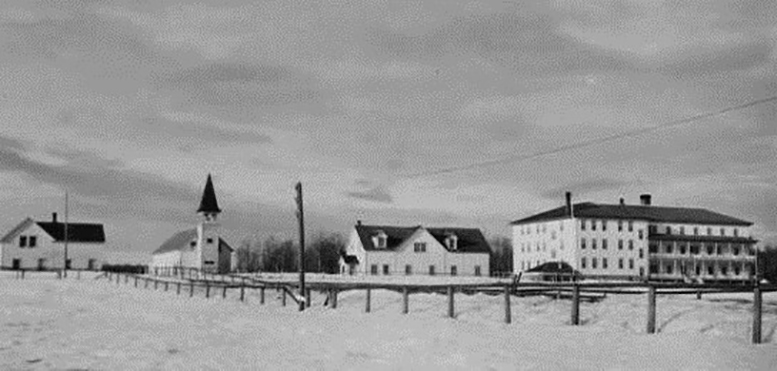by Kinnukana, Local Journalism Initiative Reporter
(ANNews) – Between June 23-25, 2023, over a thousand registered Survivors, descendants, and community members from across Treaty 8 attended a gathering at the site of the former St. Bruno’s Indian Residential School (St. Bruno’s) to reflect on the Final Summary of the Phase 1 Ground-Penetrating Radar Search at Joussard Mission, AB report just released by the University of Alberta. The University of Alberta’s Institute of Prairie and Indigenous Archaeology was contacted by the Lesser Slave Lake Indian Regional Council (LSLIRC), Sucker Creek First Nation and Driftpile Cree Nation to undertake an advanced ground-penetrating-radar geophysical search for unmarked graves at St. Bruno’s in Joussard. Much of the technical data was obtained in the Summer of 2022 and has been undergoing rigorous analysis and interpretation since it was collected.
This is one site of many across Canada where communities continue to search for unmarked graves at former Indian residential schools. St. Bruno’s was operated by the Catholic Church from 1913 to 1969 and was located on the south shore of the Lesser Slave Lake. The objectives of the gathering were to share the findings in the report, allow time for participants to grieve and provide them with culture, wellness, and ceremonial supports. The report supports oral testimonies and records that have been collected from Survivors and other sources over the years on the horrific treatment Indigenous children endured at the residential school.
The event was opened by Sucker Creek First Nation Chief Roderick Willier, a Survivor of the school, and Driftpile Cree Nation Chief Dwayne Laboucan. The local Chiefs and the University of Alberta released the report which showed eighty-eight potential unmarked graves were found within 1.13 acres of land. The report uses the phrase “potential unmarked graves” and notes that the results are not meant to be taken as definitive proof of eighty-eight grave sites. Fourteen of those graves are listed as ‘likely’ meaning that there are multiple indicators, such as the size and shape of a potential grave. According to the report, ground penetrating radar is not able to confirm the presence or absence of human remains, but it does help to pinpoint locations where further analysis of study is needed. The University team found signs of unmarked graves outside the school cemetery area at two locations, one of them was near the priest’s residence and the other was close to the workshop on the school’s grounds.
This was painful news for the participants. There were various reactions at the event and lots of emotional tears. There was a blanket ceremony where generational Survivors were asked to come forward and they were wrapped in blankets. Two hundred and fifty blankets were used to comfort Survivors. Shane Pospisil, Executive Director, LSLIRC said, “It was my first blanket ceremony. It was very symbolic and very powerful. People were comforted and hugged. This process is important because it allows people to grieve and then begin the healing process. They can also celebrate their strength, resilience and attachment to their culture, traditions, and ceremony.”
Ground penetrating radar is only one step in the process of identifying unmarked graves. There will need to be alternate ways of confirming whether the graves are actually present. From the beginning of this project, an advisory committee made up of two Survivors from each of the outlying communities meet on a periodic basis to assist with identifying search areas, advising on the approaches to take, planning the gathering and guiding leadership on the necessary work.
The next phase of the project at St. Bruno’s will be to expand the ground penetrating radar to twenty acres and focus on other high potential areas. A review of oral testimonies and other archival records will also be done. Shane said, “We are going to find more is my sense. We can clear the air on what the numbers are. It is not a matter of if there are unmarked graves, we all know that, but we are going to have to continue to work because it requires clarity. You cannot move forward in a process without knowing what happened and what the impact is. Understanding what happened at these sites is part of the healing process.”
The work on identifying potential graves is not something that can be rushed, and it will take time. It is extremely important to do this work in a respectful manner. The leadership and the communities are not planning to disturb the graves. Over time, they are hoping to be able to repatriate the land, take over the care of the gravesites and regain their power over an area where there was disempowerment that went on for far too long.
“The St. Bruno’s site we are standing on this afternoon is sacred and hallowed ground for our People, and lands that must not be disrespected as they have by some in the past…whether unintentionally or not,” remarked Chief Willier.
“Rather than repatriating the remains of our loved ones, our precious little ones, as some have suggested…many of us now strongly believe that the former residential school site itself is what needs to be repatriated. This, to further empower our People on the very site that was meant to disempower our children, our families, and our communities.”
“I am among those who believe this needs to happen,” he concluded, “so that we truly honour those who never made it home and allow them to respectfully, and with dignity, find true and lasting peace.”
To obtain an electronic copy of the Final Summary of the Phase 1 Ground-Penetrating-Radar Search at Joussard Mission, AB (January 20, 2023) contact Shane Pospisil at [email protected]



Be the first to comment on "Search for unmarked graves helps Survivors and others gain clarity and begin healing process"